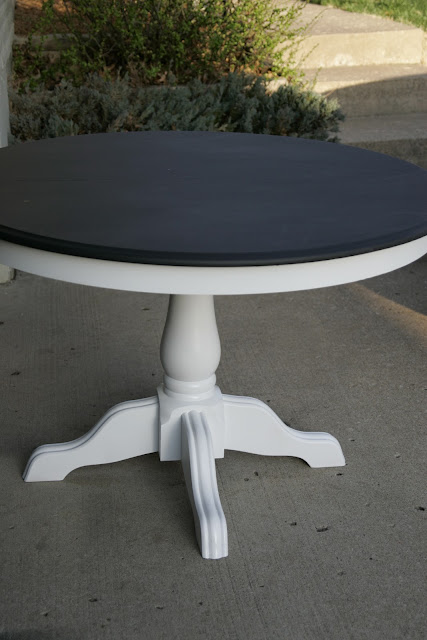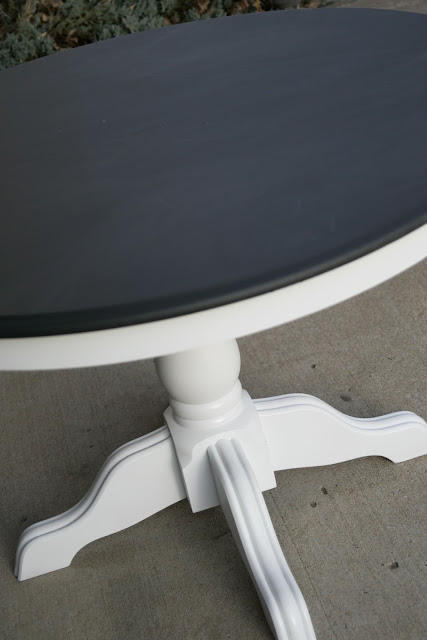Another Pinterest Project
Thankfully, Saturday was nice enough that once we had the kids down for their nap my mom and I were able to start on a few projects for the new house. With her help, I was able to prime both the wrought iron bed for Kaden and a table that Justin picked up for our breakfast nook in the new house. Both Craigslist items. Both pretty cheap. And both were inspired by none other than Miss Pinterest herself.
Unfortunately it rained all day on Sunday so I wasn’t able to get the bed back out and work on it but the table was a different story. I had already painted the pedestal so all that was left to do was paint the top with chalkboard paint. It took only two coats of paint and we are ready to put it to work.
I forgot to snap a before picture of the table but it looked a little like this….

The inspiration:

My Pinterest Version:


And although it is currently sitting in our basement, not being used, I can’t wait for our first morning in the new house and to have breakfast around the table. Kaden scribbling away, drawing Mater and McQueen and Daddy cooking pancakes. I hope this table will be the center of many, many family meals where we share our roses and thorns from each day.
You’ll have to come back and check out what we decide to go with for chairs. Not sure if I want something simple and plain, sleek and modern, a bright color or a neutral color. So many choices and only a few weeks to decide.
Finding the Ideal Chair for My Academic Needs
I decided lately it was time to replace my study chair. After all, my previous chair wasn’t cutting it anymore given so much time spent working from home.
Learning to balance a job with a degree has helped me to understand just how important a decent chair is. Comfort and support became non-negotiable with my days divided between employment duties and late-night study sessions.
Often I found myself juggling coursework and work calls, and a bad chair simply made my back discomfort worse, thereby making concentration more difficult. Investing in a suitable chair would help me keep concentration and stamina, therefore enabling me to maximize my limited study time without needless suffering or distraction. When you have to be at your best and balance several roles, it’s incredible how much of a difference the proper chair can make.
I sought a chair that would support my back, be comfortable, and enable me to stay concentrated. I read a lot of reviews, conducted extensive research, and even tried out a couple seats. This is what I found, together with the advantages, drawbacks, and key characteristics to be on lookout.
My Checklist: What I Needed in a Study Chair
Before I started looking, I made a quick list of what I needed from a chair:
- Comfortable for Long Hours: I needed a chair that wouldn’t make me feel stiff or sore after hours of sitting.
- Ergonomic Support: I wanted to avoid back pain, so good lumbar support was a must.
- Adjustability: I needed a chair that could adjust to fit my height and desk.
- Durability: I didn’t want to replace the chair anytime soon, so it needed to be sturdy.
- Design: Since it would sit in my home, I wanted it to look good, too!
Pros and Cons of Different Chairs
I ended up considering several types of chairs, and here’s the breakdown of what I found:
Ergonomic Office Chairs
Pros:
- Excellent lumbar support and adjustable features like seat height, armrests, and backrest tilt.
- Designed specifically for long hours of sitting, reducing strain and improving posture.
- Many come with breathable mesh backs, which helps prevent sweating.
Cons:
- Particularly the high-end ones, can be somewhat costly.
- Some designs can look a bit too “office-like” for a home study setting.
Traditional Wooden or Upholstered Chairs
Pros:
They blend well with home decor and come in a variety of styles and finishes.
Often more affordable than high-end ergonomic or gaming chairs.
Good for short study sessions or occasional use.
Cons:
Lack of ergonomic features, which can lead to discomfort during long periods of sitting.
Generally, not adjustable, making it hard to find a perfect fit.
Limited support for the back and neck.
Kneeling Chairs
Pros:
Promotes an active sitting position, which can help improve posture and strengthen core muscles.
Smaller and more compact, taking up less space in the study area.
A unique alternative for those who find traditional chairs uncomfortable.
Cons:
Takes time to get used to, and not everyone finds them comfortable.
Limited adjustability and lack of back support may not suit all users.
Not ideal for prolonged sitting or those with certain knee or leg conditions.
Things to Pay Attention To
Through my research, I learned that there are several key features to focus on when choosing a chair:
- Adjustability: For me, this was a must. Perfect chair fit for your body and desk arrangement depends on your capacity to modify armrests, backrest tilt, and seat height.
- Material and Breathability: While leather or synthetic leather can look more fashionable but may induce perspiration in hot weather, chairs with mesh backs were excellent for remaining cool.
- Lumbar Support: Perfect is a chair with changeable lumbar support. It helps to preserve the spine’s natural curve, therefore lessening back pressure.
- Cushioning and Seat Depth: A chair too soft or too firm can be problematic. The seat depth should allow you to sit with several inches of space between the back of your knees and the seat edge, so orienting your back against the backrest.
- Mobility: Although wheelchairs are fantastic for getting about, I had to take floor type into account. Hard plastic wheels can ruin hardwood flooring, hence I searched for chairs with soft rubber wheels or considered a floor mat.
The Importance of a Good Study Spot for Effective Studying
Just as much of a factor as selecting the correct chair is establishing a good study area. Your focus, output, and whole learning experience may be much enhanced by a well-designed study environment. Especially when juggling my degree with employment, I found that maintaining excellent time management and keeping oneself motivated depended critically on creating a separate study space.
More than just a desk and chair, a good study area is about setting up a space free of distractions so that focus may be strengthened. Away from busy places and commotion, a peaceful, well-lit part of my house proved to be most ideal. Good lighting—probably natural—helped to lower eye strain and kept me more awake. Maintaining a clutter-free study space also made a big difference since it helps to clear mental congestion resulting from disorganized surroundings.
I also understood that adding a few inspirational phrases, a plant, or other little décor item to personalize the study area would provide some comfort and inspiration, therefore enhancing the appeal of the place. Beyond appearances, having simple access to all my study materials—books, notes, and a laptop—helped me keep momentum and prevent the aggravation of always looking for anything.
In order to keep a good work-study-life balance, I finally found that establishing a specific study area helped me to clearly separate study time from leisure time. It enabled me to swiftly and effectively mentally enter “study mode,” therefore optimizing every session.
